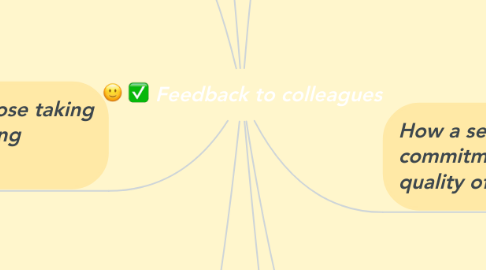Feedback to colleagues
von Alejandro Hndz

1. Delivering “hard” messages to colleagues
1.1. Explore alternative ways of delivering a particular concept or managing a particular learning environment.
1.2. hard messages are sometimes necessary
1.3. It is important to shift the focus of the exercise by concentrating on pupil outcomes and not simply on the teacher’s performance.
1.4. An effective method to give hard feedback is the “good news, bad news sandwich”
2. Methods of developing the skills of middle leaders
2.1. Feedback had been delivered with a “model of good practice in feedback
2.2. teachers have had some experience of good constructive dialogue
2.3. “Middle leaders are put in the position of having mock... observations and [have to provide] mock feedback”.
3. Practical advice for those taking up the role of improving curriculum delivery
3.1. starting the feedback session by asking the teacher how they felt the lesson had gone, so that they could “put down their marker” and feel that they could exercise some control over the session.
3.2. The key elements of the success of developing observational and feedback skills within the school was that it relied on colleagues in the school and the power of working with people that you know and respect.
4. As an observer giving feedback
4.1. You provide feedback on the teaching performance, not the person.
4.2. Link your comments to specific moments in the teacher’s lesson.
4.3. Try to avoid insincere praise. Follow up constructive comments with your ideas for improvement or things to try.
4.4. This process is about the teacher you are observing. Avoid grandstanding or one-upmanship.
4.5. You’re not providing a summative evaluation of this person’s teaching—you’re helping the teacher identify what to try next time.
4.6. Instead of saying “You should do this...” or “Don’t do that...”, phrase your suggestions as stemming from your own observations.
4.7. Avoid pointing out challenges the teacher cannot reasonably change or address.
4.8. Too many comments will overload the listener. Focus on one or two key points.
5. The importance of Feedback
5.1. constitutes a highly practical method for a senior leader to monitor the implementation, at classroom level, of the school’s priorities in its development plan
5.2. To give some strong and supportive messages to colleagues
6. How a senior leader can secure commitment to improving the quality of teaching and learning
6.1. so teachers have become much more comfortable with the process of being observed, of observing others and of entering into dialogue about that observation process.
6.2. Ending “style” would always include an agreed focus on future potential strategies that the teacher would try so that they could evaluate and discuss further.
6.3. one of the key things about good observation and good feedback is that the purpose of the observation is made clear at the start of the session.
6.4. it is important to emphasise that this was a “discussion amongst equals, so that [as observer] you’re not sitting behind a desk but sitting in similar chairs facing each other”.
6.5. It is important to deliver the feedback “in the form of a conversation, and a sharing of professional knowledge and understanding”.
7. FEEDBACK ON TEACHING
7.1. When providing feedback on a colleague’s teaching performance, it is important to remember that our role is not to judge or evaluate a person’s approach to teaching or teaching style, or to demonstrate everything that we might know about teaching.
7.2. You provide feedback on the teaching performance, not the person.
8. As the teacher receiving feedback
8.1. As soon as you invite someone’s opinion, you need to be prepared to hear it! If you hear what you perceive to be negative comments, separate the comments from yourself as a person and focus on what could be changed next time to improve your teaching.
8.2. The observers providing you with feedback will need positive reinforcement.
8.3. Be specific when asking for feedback.
8.4. Ask an observer to rephrase a comment or paraphrase back to the observer what you think she/he is saying.
8.5. Once you’ve heard all the verbal feedback, reflect back on your self assessment of your lesson and think how your own assessment of your teaching compares with the observations of your colleagues. What have you learned?


